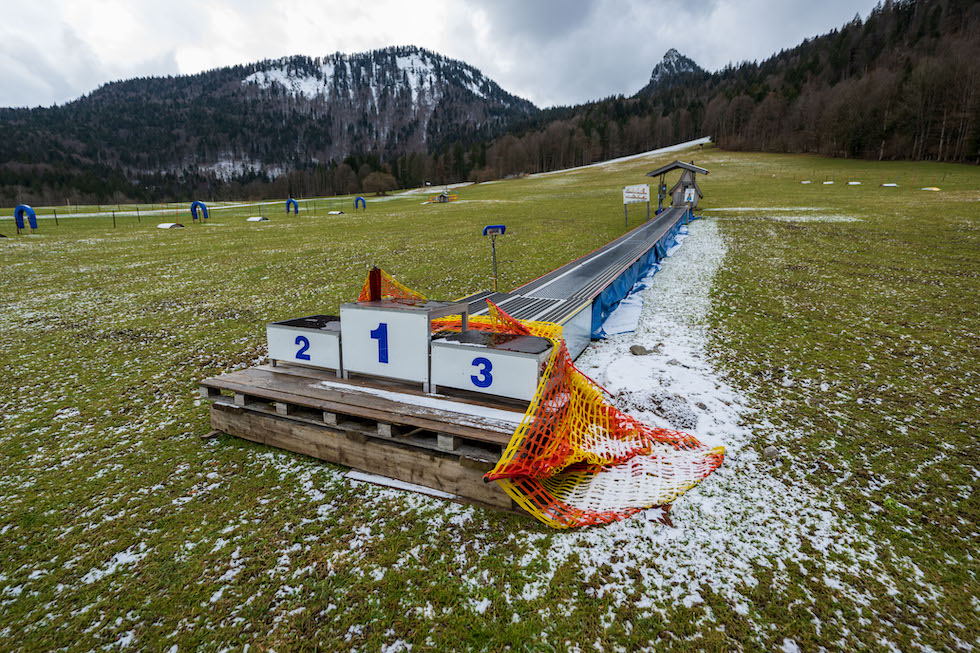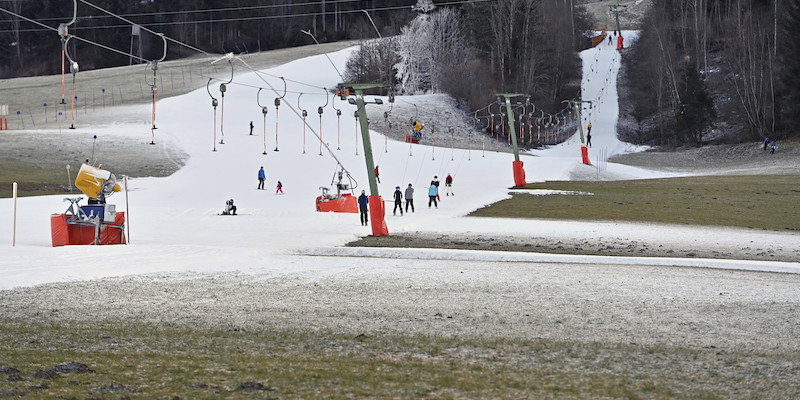Also this winter, as happened last year, the lack of snow has reduced many ski slopes in the Alps to thin white strips of artificial snow, surrounded by the green of the woods and the yellow of the arid mountains. There is little snow in the Alps and the Apennines due to meteorological conditions very similar to those of the winter of a year ago: in the last three months temperatures have been exceptionally mild and rainfall scarce.
The lack of snow in Italy is more serious and frequent today than in the past, and it inevitably affects winter tourism, one of the sectors of the economy most sensitive to climate change. In recent years, various studies have tried to understand what will happen in the coming decades and the conclusions are all very similar: the snow will fall starting from ever higher altitudes and the ski lifts will have to find alternatives to the ski slopes in order to survive.
One of the latest investigations has been accomplished by the Bank of Italy, which collected data relating to ski resorts in the Alps to analyze how much weather conditions and artificial snow affect the sale of ski passes and overnight stays in hotels.
Gioia Maria Mariani and Diego Scalise, the researchers who worked on the study published in December 2022, examined the data of the last 20 years relating to 39 Italian ski resorts between Valle d’Aosta, the province of Trento and the South Tyrol. They started from the impact of mountain tourism on the entire sector: according to ISTAT, the Italian statistical institute, before the pandemic around 13 percent of all overnight stays recorded in Italy took place in mountain areas and in 2019 the spending by foreign tourists on holidays in the mountains was almost 2 billion euros. These data make it clear how global warming caused by human activities, which directly affects mountain tourism, could have consequences on the economy of the entire sector, one of the most important in the Italian economy.
Mariani and Scalise examined snowfall data from the last 20 years to measure the effect of the weather on ski pass sales and overnight stays. They then estimated how much sales were boosted by artificial snow. And finally, they applied the climate models recognized as the most reliable to hypothesize some scenarios for the coming decades.
In the last 20 years, a widespread increase in temperature has been recorded in the analyzed localities accompanied by a decrease in snowfall. The situation of the ski resorts in the Valle d’Aosta and in Trentino-Alto Adige is very different, not only geographically: those in the Valle d’Aosta are on average at a higher altitude and the neighboring villages have fewer inhabitants, with a hotel offer more limited.
– Read also: In the Alps there are no longer the snow days of the past
As was easy to predict, the study confirms that there is a significant relationship between snowfall and winter tourist flows, and therefore on the sale of ski passes and overnight stays in Italian Alpine resorts, regardless of the region and the type of hotel. Artificial snow, on the other hand, has little effect, despite the Alpine resorts making ever more massive use of it: according to the Bank of Italy study, there is little correlation between the use of artificial snow and tourist flows.
In short, if there is no natural snow, much fewer ski enthusiasts and tourists in general arrive, even if the lifts are open thanks to the support of artificial snow. This result demonstrates that in Italy, and in other countries where winter tourism has developed, it will be necessary to carefully evaluate the possible benefits of artificial snow, probably limited, in the face of a significant economic and energy impact.
A stationary snow cannon (Peter Kneffel/Dpa/Ansa)
Indeed, one of the most underestimated aspects of artificial snow is the consumption of water and electricity. With one cubic meter of water it is possible to produce an average of 2.5 cubic meters of snow. To cover one hectare of slope with snow – that is, a strip 1 km long and 10 meters wide – with a 30-centimetre-high base layer, around one thousand cubic meters of water are needed, almost half the water contained in an Olympic swimming pool. Furthermore, for the same hectare of track, between 2,000 and 7,000 kilowatt hours are needed.
The functioning of the so-called snow cannons also depends on the weather conditions: if the temperature is too high, only a jet of water will come from the cannons. The ideal weather conditions for excellent artificial snow are between -2° and -12°, and a humidity rate of 20%.
– Read also: Artificial snow has its problems
In recent years, many ski resort operators have had to wait longer than usual to start the artificial snow due to the high temperatures in December. In the coming decades, many studies and climate models say, conditions will worsen: the increase in temperatures will shorten the ski season and move snowfall higher.
According to estimates by Bank of Italy researchers and forecasts on meteorological variables, already in the next few years – without making longer-term forecasts – the sale of ski passes could decrease by an average of 7 per cent due to climate change, and in particularly in places at a lower altitude, for example in Trentino Alto Adige. “The costs of artificial snow will increase with temperatures,” the study reads. “Snowmaking will simply no longer be feasible in the lower-lying areas, which are most affected by climate change.”
The impact of rising temperatures on overnight stays, on the other hand, would be less serious. “In this context, adaptation and strategies based on the diversification of activities and revenues are crucial,” the researchers continue. «Investments could be made to reduce the dependence of the mountain economy on snow conditions: for example, by increasing the commitment to tourism throughout the year, stimulating and promoting summer tourism, but also activities independent of the winter weather such as competitions winter running, congresses, educational and well-being events».
– Read also: What’s behind a ski slope
One arrived at the same conclusions, particularly regarding the impact of artificial snow published study at the beginning of December by some Swiss researchers who analyzed the data of the large ski area of Andermatt, Sedrun and Disentis, in the canton of Uri. To evaluate the possibilities of economic survival of the plants, the researchers considered two indicators: the probability of having a snowpack for 100 consecutive days, regardless of the time of year, and a stable snowpack between Christmas and New Year, a period in which around a quarter of annual revenues are concentrated.
The results of the study explain that the reduction in snow forecast by the end of the century will be able to be partly compensated by artificial snow, at least at the highest altitudes: below 1,800 meters it will not even be possible to have artificial snow because the weather conditions will not be suitable.
An increasingly massive use of artificial snow, however, will have consequences: water consumption will increase by 79 percent by the end of the century and the artificial lake Oberalpsee, the main source used to power snow cannons, will no longer meet the need water in the region. High water consumption could lead to competition of water supply with other sectors, for example with hydroelectric power plants. Despite these obvious problems, according to the study, the Andermatt, Sedrun and Disentis area has an advantage over other places at lower altitudes, which is why tourists could increase, even if at considerable costs.

(Peter Kneffel/dpa/Ansa)
The different estimates on the poor sustainability of the plants located at low altitudes raise many questions about the opportunity to continue investing in ski resorts destined to be little or not at all profitable and attractive.
In the last Legambiente report on the subject, called Nevediversa, some cases of «therapeutic obstinacy» have been identified, as they are defined by the environmental association: these are plants that already survive today only thanks to the economic support of the institutions. Among these are Col du Joux, in Valle d’Aosta, at an altitude of 1,600 metres; Bolbeno, in the province of Trento, which received 4 million euros for plants at very low altitudes, between 560 and 660 meters in height; Corno alle Scale, on Mount Cimone, in the Emilian Apennines, which has been granted a non-repayable loan of 20 million euros for lifts open only with artificial snow; Biemonte, in the province of Biella, between 1,500 and 1,650 meters high. This map shows the disused plants in Italy.
Legambiente surveyed 234 abandoned plants and 135 structures temporarily closed due to economic or management problems. «Ski tourism, which in the recent past has played a driving role for the mountains, now needs to shed its skin», write Vanda Bonardi and Sebastiano Venneri of Legambiente in the introduction to the dossier. «It would be an unforgivable mistake if it were not recognized, first of all for the local communities. We are faced with a mountain that changes visibly, where it will be increasingly difficult to identify the winter season with alpine skiing and for this reason it will need to be reconfigured into a broader idea of sustainability, capable of encompassing overall visions the possibilities of living in the highlands”.
